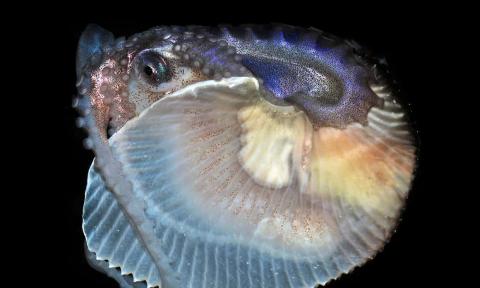
Astronauts of the Sea
How argonaut cephalopods evolved their own architecture to return to the open ocean.
Cephalopod molluscs, the group of animals that includes octopuses, nautiluses, bobtail squid and cuttlefish amongst its living members, is a small but highly diverse group of animals. The group boasts ocean giants, colour and shape changing octopuses, luminous ink squirters, transparent deep sea squid, aquarium escape artists, animals that mimic other animals, giant eyed vampire squid and they’ve even conquered the air in species that fly, yes fly (Muramatsu et al. 2013).
In short, it’s really hard to stand out at a cephalopod party without doing something really spectacular and yet there’s one group of octopods, the argonauts, which have a remarkable evolution on a par with the evolution of flight in vertebrates or the many groups like whales and dolphins which evolved from terrestrial ancestors to return to the ocean.
Argonauts, several species in the genus Argonauta, are a group of octopod cephalopods, the group that contains all the eight armed, soft bodied cephalopods. Collectively they’re known as octopuses but perhaps confusingly there’s a large number of species in the genus Octopus and many other genera of non-Octopus octopuses too such as Argonauta.
Argonauts get their name from the sailors of the Argo from “Jason and the Argonauts” fame.
What but what the argonauts are best known for is the calcite shell they make, which gives them the common name Paper Nautilus (although they aren’t closely related to true nautiluses which grow a hard outer shell). The delicate shell or case of argonauts have been washing up on shorelines for centuries puzzling naturalists as to who made them and how.
Initially it was thought that these were just the remnants of a shelled creature. When shells were found with cephalopods living inside them which weren’t attached to the shells, it was speculated that crafty octopuses had borrowed them from another creature much like hermit crabs appropriate gastropod shells to live in.
It wasn’t until the nineteenth century, however, that Jeanne Villepreux-Power showed once and for all that argonauts create their own shells but not like other shelled molluscs. Females secrete the shells from modified arms and aren’t attached to the shells. They can be removed from the cases they make and they can patch up holes although experimentally they die when removed from the cases for prolonged periods of time.
Males do not make these thin calcite shells although sometimes males are found loitering in the egg cases. Female argonauts form comedic awkwardly bobbing chains at the surface of the ocean and some species feed by spreading their modified web arms across the surface of their shells snatching food particl es that come into contact with them. They have also been found attached to jellyfish, chewing through the top of the bell to steal food from inside.
